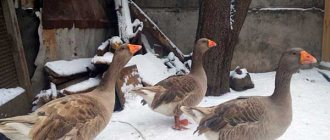What does the bird look like?
From the name it becomes clear that the bird’s plumage is grayish, so its appearance is quite modest. Only the abdomen is painted white , the back, wings and tail are gray. On the abdomen the adult has a spot resembling a horseshoe, colored brown. Young females do not have such a distinctive feature. Sexual characteristics are weakly expressed: the female is slightly smaller in size and her plumage is duller than that of the male. The spot appears when the female reaches sexual maturity and is ready to breed. You can distinguish a female from a male by its tail; in the summer, females develop red feathers.
The head of both sexes is brownish-brown, with a richer dark color on the crown and back of the head. The plumage of the entire partridge has a pattern of small specks and spots.
Habitats
The partridge is found over a wide area:
- From the North of Portugal and the coast of England to Altai. These birds no longer settle beyond the Ob River.
- Towards the north, partridges live up to the White Sea.
- In the south and east they live up to the borders of Iran and Asia Minor.
Gray partridges build a nest in an open area of a field, steppe or meadow .
They prefer open spaces with bushes, ravines, and wide beams. Sometimes flocks of partridges fly in to feast on oats, millet or potatoes, which are rich in farm areas. In autumn, gray partridges move to the forest-steppe, prefer a landscape with dense weeds, and settle on forest edges, avoiding thickets. Tall grass and bushes serve as a refuge for her from enemies.
The gray partridge is a sedentary bird . Her entire life passes in approximately the same territory. Only a lack of food forces her to leave her inhabited areas and go in search of food. It does not tolerate such migrations easily; forced relocations turn the gray partridge into a very timid bird.
In winter and autumn it leads a gregarious lifestyle. In the spring, during the breeding season, gray partridges break into pairs. Each pair has its own site for building a nest.
How partridges winter. What you need to know about partridges
Photo by Evgeny Anufriev
The gray partridge in the Moscow region is distributed unevenly, but is found in virtually all areas. The southern and southeastern regions, such as Serebryano-Prudsky, Zaraisky, Voskresensky and Kolomensky, are considered the most “partridge-rich” among hunters.
A relatively high density of partridges is also observed in some northwestern regions, for example in Volokolamsk. Over the past fifteen years, our company of Kurzhaarists regularly visits these places, especially in October - November.
The number of gray partridge is subject to very strong fluctuations, primarily related to climatic conditions and the availability of available food resources. Partridges die the most in cold, snowy winters. Then they can often be observed near human habitation. Birds easily get used to people and vehicles and often simply go out onto the road in populated areas in search of food.
One of my comrades in the pigeon sport, who lives in the Dmitrovsky district, told me that all winter a flock of partridges lived right in his garden, gratefully accepting offerings in the form of grain waste left after feeding the pigeons.
For the last two years, the Moscow region has had relatively warm winters; in addition, the rainy summer of 2013 did not allow many farms to harvest grain crops on time. Unharvested fields were left to spend the winter with wheat sometimes sprouted right in the ear. All this, of course, had a beneficial effect on the growth in the number of gray partridge. Those legging hunters who have already been lucky enough to hunt partridges this year unanimously note a simple surge in their numbers.
Our company’s favorite place to hunt partridges for many years has been areas that actually run along the border of the Moscow and Ryazan regions. There are many ravines with streams flowing along their bottom. Fields with winter crops are often adjacent to areas that are fallow and heavily overgrown with weeds - all this creates optimal conditions for the reproduction and prosperity of the partridge tribe.
Classification
There are three species in the genus of gray partridges:
- Gray,
- bearded,
- Central Asian.
The appearance of the gray partridge and bearded partridge is very similar. That is why they are often combined into one. Representatives of these species became victims of hunting and agriculture, so there are few of them left.
The Central Asian partridge lives across a wide area of the Tibetan Plateau . The color of its feathers is significantly different from its relatives: on the front of the head the plumage is white with two characteristic bright black spots, the chest is in dark stripes. Bird populations are stable and numbers are not decreasing.
Nutrition
In summer, the bird mainly feeds on plant foods.
Autumn is harvest time, so partridges fly to grain harvesting lands, after which they move to fields with beets and corn, and also feast on sunflower and flax seeds. Weed seeds are also used. In late autumn, fruits and grains found in meadows, steppes or weeds act as food. Young individuals feed only on insects. Flocks of partridges migrate to feed early in the morning . During the day and evening, birds hide in places that are difficult for predators to reach, for example, in thickets.
Reproduction
Gray partridges are monogamous. The male takes an active part in raising the offspring. The mating season is accompanied by a characteristic cry that spreads over large areas. With this exclamation, partridges attract the attention of their relatives, and also take off with it.
The nest is a small depression in the ground. Birds place plants at the bottom of the hole. The diameter of the dwelling is about 20 cm, the depth is approximately 7 cm. The nest is built in May. The chicks hatch in early June. The pair builds its nest in a safe place, hidden from the eyes of enemies. It is found in dense thickets, tall grass, and forest edges. The clutch consists of 10-25 eggs of a grayish-brown color. The shape has sharp and blunt ends. The female lays eggs at intervals of one day. The female incubates the eggs for approximately 23 days, leaving rarely and only briefly to feed. The male is always nearby, guarding the female and the clutch; in case of danger, both leave the nest, but always return when it has passed.
The offspring hatch in one day and immediately begin to lead an active lifestyle, without even having time to dry out. They can already follow their parents even at a distance of up to 200 m. The chicks reach adult size by one and a half months.
At the age of one week they can already fly for a short time, and at 14 days they can already travel long distances in the air. If one of the parents dies, the second parent takes care of the family. If both die, the entire brood is taken into the care of another family, which is always ready to accept new members.
When a family is in danger, they act differently: they can fly up and, after flying some distance, descend. If a predator threatens to attack, members of the family fly up and split into groups, then hide in the bushes. When the predator retreats, the male unites the chicks into a flock again.
Lifestyle
Birds lead a sedentary lifestyle and rarely leave their habitat. An individual can decide to take such a step only in case of danger or when there is a lack of food in the previous area of residence. But such movements have a negative impact on the bird; it becomes timid and nervous.
We suggest you read: Keeping exotic animals at home
In winter, partridges try to stay close to where people live. They can choose courtyards and buildings, as well as densely growing bushes.
In autumn and winter, the gray partridge prefers to lead a gregarious lifestyle, 30-40 birds each, and in the spring, during the mating season, individuals split into pairs. Each bird “family” chooses its own area to live and build a nest.
In captivity, gray partridges live 10 years or more, but in the wild, such a life expectancy among individuals of this breed is rare. Frequent lack of nutrition takes its toll, and birds are often destroyed by predatory animals and birds, or they become prey for hunters.
The gray partridge can live more than ten years.
Partridges reach puberty by 1 year. Their mating season begins in March or April, depending on climatic conditions. Having chosen a partner, females arrange nests in tall grass, near trees and bushes. They insulate the inside of the “house” with feathers, leaves and soft grass.
Surprisingly, female partridges are capable of laying from 12 to 25 eggs per clutch. The survival rate of offspring is very high.
Partridge eggs are monochromatic, have a greenish or dark gray shell and an oval shape, and their weight is 13-15 g. Hatching lasts about 25 days. Moreover, the female and male regularly replace each other.
Chicks are born in the last days of May or early June. From the very first days they are able to move independently and run quickly. Parents, trying to protect their offspring, almost immediately move the chicks 200-250 meters from the nest location.
A gray partridge hen hides a nest in the grass.
It is worth noting that the families of gray partridges are extremely friendly. The male helps the female not only in the process of incubating eggs, but also actively participates in feeding, raising and protecting the offspring. When attacked by predators, the head of the family tries to take the entire blow on himself and it happens that he dies while protecting the female and cubs. The chicks are characterized by rapid growth rates, and reach the size of an adult bird by the age of 3-4 months.
In autumn and winter, the gray partridge prefers to lead a gregarious lifestyle, 30-40 birds each, and in the spring, during the mating season, individuals split into pairs. Each bird “family” chooses its own area to live and build a nest.
The gray partridge can live more than ten years.
Surprisingly, female partridges are capable of laying from 12 to 25 eggs per clutch. The survival rate of offspring is very high.
A gray partridge hen hides a nest in the grass.
Gray partridges are ground birds. In summer they sleep on low bushes and in tall grass, in winter - on the ground. In the northern regions, birds sometimes migrate. Such movements are caused by several reasons:
- increase in flock size;
- harsh winter;
- lack of food;
- human development of bird habitats.
With the exception of the mating season, gray partridges keep in flocks of 15-30 birds. The basis of such a group is a brood that has not broken up since the summer. Birds do not show aggression towards each other. In the morning they move to their feeding areas. In the afternoon the flock flies under the cover of bushes and grass.
Birds that remain to spend the winter in their homeland flock into larger (up to 100 individuals) flocks. In search of food, they move to grain storage facilities and sometimes fly into poultry yards.
Nutrition
The diet of partridges consists of 90% seeds of cereals and weeds. The main delicacy for birds is buckwheat and millet. At an early age, birds feed only on animal food: insects, worms and caterpillars. From three weeks of age, the chicks switch to plant food, which is predominant. Birds willingly eat young leaves, buds, berries, wheat and rye sprouts. Like all members of the chicken family, partridges peck small pebbles, which they need for digestion.
The winter diet is very poor and contains dry herbs, which the birds obtain by shoveling snow. At this time, flocks prefer to settle closer to humans, firmly settling on haystacks and barns.
Reproduction
In mid-spring, partridges divide into pairs and occupy places for future nesting. At this time, males actively fight with each other for females.
The nests are small holes. These are most often female-expanded depressions of natural origin, located under a hummock or bush and lined with brood feathers, grass and leaves.
Mating of birds occurs from April to June. Usually in May, females lay oval eggs, colored brown-beige with an olive tint. The number of eggs ranges from 8 to 25, depending on the age of the female. Interestingly, the male takes part in incubation. Birds incubate eggs for 20 to 25 days.
Description of behavior
The gray partridge is a sociable and cautious bird. She senses the approaching danger from afar. These representatives of the pheasant family are peaceful. Males show aggression only during the mating season or when defending their nest. Partridge families are incredibly strong. Birds are caring and gentle parents, caring for and protecting a large family, the number of which can reach 15 chicks.
The species of gray partridge is prey for almost all predators. In the northern regions they are threatened by wolves, arctic foxes, and medium-sized birds of prey (gyrfalcons, peregrine falcons, owls). In the southern regions, partridges are hunted by ferrets, foxes, representatives of the medium-sized cat family and large feathered predators (kites, eagles, eagle owls). Flocks of stray dogs can cause great damage to birds.
Partridges are protected from predators by the color of their plumage, which camouflages them well in the grass and bushes, as well as their natural intelligence. In case of danger, the bird freezes. If the enemy nevertheless notices his victim and attacks, it takes off and moves away with lightning speed.
We suggest you read: How to make a nest for a Muscovy duck. How to prepare a room and nests for Indo-ducks? Making homemade nests
Of the unfavorable weather factors, the first place is occupied by cold winters with a lot of snow and drought in the warm season. These phenomena can lead to the death of birds. The reason for the disappearance of birds is also chemicalization (fertilization of fields with pesticides).
Enemies of partridge
Natural enemies of birds are: kites, gyrfalcons, owls, foxes, ferrets, arctic foxes, manulas and many others.
Therefore, the life of a partridge is short - it barely lives to be 4 years old. So, the gray partridge bird is distributed over quite vast territories; it remains to winter at home, since it does not tolerate forced migrations well. Makes a nest in the thick of grass and bushes, hiding from predators. Raising numerous offspring lies on the shoulders of both parents; the chicks quickly grow and become stronger, since in another situation the population will quickly disappear, since the partridge has many enemies.
Partridge bird
Where partridges winter in the wild. Gray partridge: habitat, description and features
Taxonomy
Russian name
Gray partridge
Latin name
Perdix perdix
English name
Gray partridge
Order
Galliformes
Family
Phasianidae
Status of the species in nature
Despite the fact that due to intensive hunting, the number of gray partridge has noticeably decreased everywhere, and in densely populated areas this bird has completely disappeared, the gray partridge is a species of least concern.
Species and man
The gray partridge is an object of hunting, as its meat is tasty and nutritious. They have been hunting it since ancient times; before the advent of guns, these birds were caught with nets.


